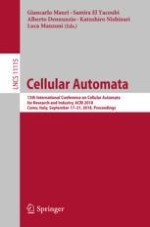Abstract
Cellular Automata (CA) models have been applied to different fields of knowledge, from cryptography, arts, to the modelling and simulation of complex systems. In the latter area, however, sometimes the ability to properly represent complex interacting but distinct dynamics taking place within a given area is limited by the need of calibrating models in which the number of necessary parameters grows. Hidden costs related to the identification of specific values or plausible ranges for parameters can become overwhelming.
Here we model the assembly process of plant communities after fire. The number of elements of plant communities (plants of different species) and processes involved (seed dispersal, plant recruitment, competence, etc.) require a high degree of parameterization because all those processes have great relevance on the evolution of the system, for instance during post-fire recovery.
The fire, aside negative effects, releases a number of resources (space, nutrients, ...) making them easily available for plants, which promptly use those resources so they are no longer available to other plants after a period of time which usually ranges from months to years. In the meantime, the plasticity of species in relation to fire and environment and the interactions among species determine the direction of changes to occur.
In this work we present a novel approach to the assembly of plant communities after fire using CA. In particular we gather the preliminary results of their application and give a feasible way to optimize the parameterization of the model.
